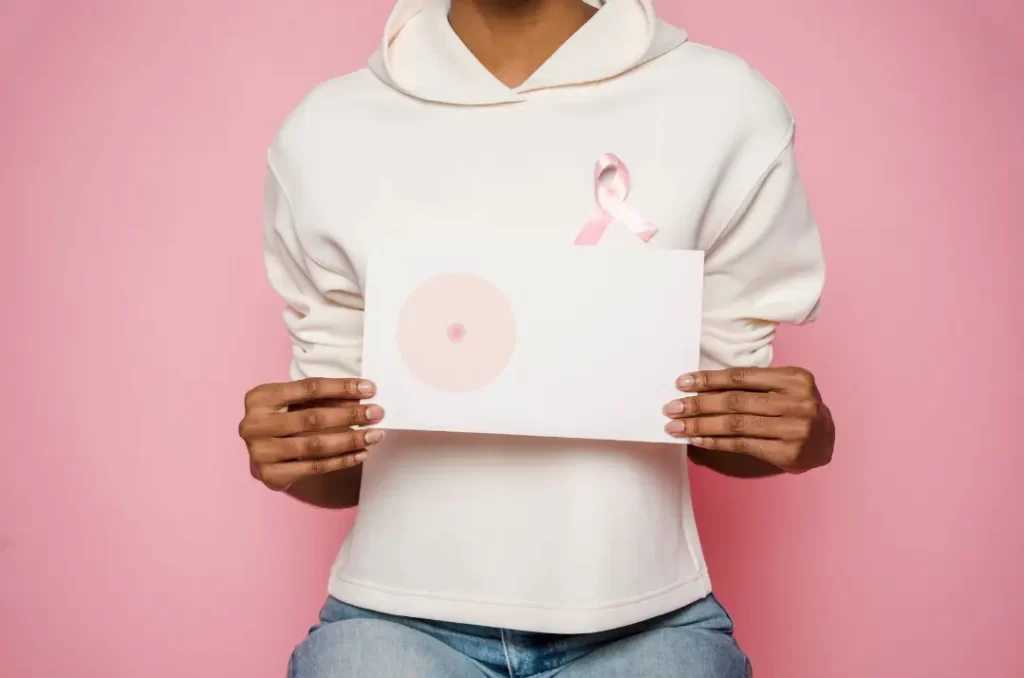If you’ve been diagnosed with breast cancer or are just generally curious, you might want to know about the stage of breast cancer. The answers will help you and the doctors understand what’s ahead and decide on the treatment plan.
Doctors have several ways to determine the clinical staging of breast cancer. They can get clues through physical exams, biopsies, X-rays, bone scans (and other images) and blood tests. A pathologist is a doctor who studies tissue samples from the breast and lymph nodes under a microscope to find out more.1 2
There are two types of breast cancer, which are non-invasive breast cancer (carcinoma in situ) and invasive breast cancer.
Breast cancer staging:
There are 4 stages of breast cancer, denoted by the number 0 and I, II, III, or IV in Roman numerals (often followed by A, B, or C). In general, the greater the number, the more advanced the cancer. However, there is more to it. Doctors tend to classify breast cancer into stages based on the size of your tumour and how much it has spread in the body.
Cancers that are large or have spread to surrounding tissues or organs are at a higher stage than cancers that are small or still confined within the breast tissue.
1. Stage 0 –
It is the first stage of breast cancer which has been diagnosed early on. It begins in the breast ducts or milk glands and has stayed there without spreading to other tissues. You’re likely to hear or see the words such as, in situ, meaning “in the original place”.
What is stage 1 or 2 breast cancer?
2. Stage 1 –
It is the initial stage of breast cancer. Breast cancer is called invasive at this stage when it has spread to attack healthy tissue.
- Stage 1A – It indicates that cancer has migrated to the fatty breast tissue. The tumour is not larger than a shelled peanut, and there may be no tumour at all.
- Stage 1B – It indicates that some cancer cells, although in tiny amounts, are found in a few lymph nodes.
3. Stage 2 cancer –
At this stage, breast cancer has grown and spread (or both).
- Stage 2A – It indicates that the tumour in the breast is still small (if present at all). There could be no cancer in the lymph nodes, or it could have spread to three or more.
- Stage 2B – At this stage, the tumour is larger, ranging in size from a walnut to a lime. It may or may not be spread to any lymph nodes.3
Is Stage 2 breast cancer curable?
Stage 2 breast cancer is very curable, and the outlook is good. Cancer cells in stage 2 breast cancer have not spread beyond the breast or nearby lymph nodes. So, is stage 2 breast cancer serious? The earlier your cancer can be discovered and treated (as with most types of cancer) the better the outcome. Knowing your stage 2 breast cancer’s HR and HER2 status might help your doctor evaluate which treatment will be effective for you.
The treatment options can include – surgery, radiation therapy, chemotherapy and targeted therapy. These treatments (like other treatments) can have some side effects, which could be mild to severe. Most clear up after treatment, although there may be some long-term complications.
Does breast cancer Stage 2 need chemotherapy?
Doctors recommend chemotherapy for some types of stage 2 breast cancer. It is usually a mixture of medications that pass through the bloodstream and kill cancer cells. A patient may receive chemotherapy before or after surgery. They may get chemotherapy prior to surgery to help reduce the size or extent of the cancer. 4
4. Stage 3 cancer –
Although cancer has not spread to bones or organs, it is said to be advanced and difficult to fight.
- Stage 3A – It indicates that cancer has spread to up to nine lymph nodes from your underarm to your collarbone. It might also spread or enlarge the lymph nodes deep inside your breast. In some cases, there is a huge tumour in the breast, but in others, there is no tumour.
- Stage 3B – It means the tumour has grown into the chest wall or skin around the breast, even if it has not spread to your lymph nodes.
- Stage 3C – It implies the presence of cancer in 10 or more lymph nodes or has spread above or below the collarbone. It is said to be 3C if there are fewer lymph nodes outside the breast, but those present inside the breast are enlarged or cancerous.5
Is Stage 3 breast cancer curable?
Stage 3 breast cancer is generally referred to as a locally advanced; but curable cancer. It is curable with intensive treatment; however, the risk of the tumour returning after treatment is high. Because stage 3 breast cancer has spread outside the breast, it can be harder to treat than earlier-stage breast cancer, though that depends on a several factors.
The treatment options include – surgery, hormone therapy, chemotherapy and targeted therapy. Your breast cancer type, overall health, and many factors beyond your control may impact the treatment outcomes. 6
5. Stage 4 –
It is the most advanced stage of breast cancer. In this stage, the breast cancer cells have spread far beyond the breast and the lymph nodes surrounding the breast. The bones, lungs, liver, and brain are the most commonly affected organs. This stage is known as “metastatic,” which means that cancer has moved beyond the region of the body where it was first discovered and detected.7
What stage is Stage 4 breast cancer?
Stage 4 is said to be the last stage of breast cancer. Stage 0 is said to be the earliest stage of breast cancer (carcinoma in situ). It then proceeds from stages 1 to 4. The lower the number, the less the cancer has spread in the parts of the body. A higher number, such as stage 4, implies that the cancer has spread more.
Can breast cancer stage 4 be cured?
Metastatic breast cancer (also known as stage 4 breast cancer) is the cancer that has spread to other organs and may cause new symptoms. Although there is no cure, treatments are available, and survival rate for breast cancer is improving over time. Early diagnosis and treatment are necessary since survival rates are higher in the early stages of breast cancer. But remember that the right treatment for stage 4 breast cancer can enhance the quality of life and longevity.
Can you live with Stage 4 breast cancer?
There is currently no cure for stage 4 breast cancer, although it can be controlled with treatments, often for years. Patients with metastatic breast cancer require treatment for the rest of their lives. If one treatment fails to be effective, the doctor can try other treatment plans.
Remember that everyone is unique, and your response to treatment may differ from someone else’s – even at stage 4. Researchers are still testing several treatment options for metastatic breast cancer. The outlook improves year after year. Consult your doctor to learn more about the factors that may affect your outlook.
Is there a stage 5 breast cancer?
Breast cancer is divided into 5 stages (from stage 0 to stage 4) but there is no stage 5 of breast cancer. So, is Stage 4 breast cancer the last stage? Yes, stage 4 cancer (metastatic breast cancer) is the last stage of breast cancer. It is the most advanced stage of breast cancer spread beyond the near the lymph nodes to various other body parts. 8
Can you live 20 years with breast cancer?
Many people with early breast cancer live for at least 20 years after getting diagnosed and treated. It is unusual for someone having metastatic breast cancer to live for 20 years. Scientists are working to improve treatments for metastatic breast cancer. 9
Is breast cancer painful?
Breast cancer is usually not painful, but if a person has unexplained breast pain or unusual breast changes, they should see a doctor. 10
How to avoid breast cancer?
According to research, even in high-risk women, lifestyle changes can reduce the chance of breast cancer. Hence, you can decrease your risk by doing the following:
- Limit your alcohol intake
- Maintain a healthy weight
- Be physically active
- Breast feed
- Limit postmenopausal hormone therapy 11
TNM staging of breast cancer:
The most common cancer staging approach is tumour-node-metastasis (TNM). Here’s more information on each element of TNM staging:
- T (Primary tumour)- This is information regarding the size and location of a cancer tumour at the time of diagnosis. Stage I tumours are those that are small and have not spread. Larger tumours are the tumours that have spread into nearby tissues and are stage II cancers. Tumours are classified from T0 to T4.
- N (nodes) – This determines whether or not a tumour has spread to nearby lymph nodes. The cancer spreads to other parts of your body via lymph nodes. The node classification ranges from N0 to N3, but node values vary based on the type of cancer. An N0 classification indicates that the tumour has not spread to neighbouring lymph nodes. A doctor can classify patients based on the location of lymph nodes and the number of lymph nodes that carry cancer.
- M (metastasis) – Metastasis occurs when a tumour has spread beyond surrounding lymph nodes to other parts of your body. An MI classification indicates that cancer has spread.
According to the TNM staging system, what are the four stages of breast cancer?
Doctors use TNM information to classify cancers into one of four stages.
- Stage 1 – This stage includes smaller tumours (T1-T2) that haven’t migrated to neighbouring lymph nodes (N) or other parts of your body (M0).
- Stage 2 – It includes larger tumours that have not migrated to adjacent lymph nodes or other parts of your body. The TNM category is T2-T4, N0, and M0.
- Stage 3 – This is used for large tumours that have spread to neighbouring lymph nodes but not other parts of your body. The TNM category is T1-T4, N1-N3, and M0.
- Stage 4 – This is called metastatic cancer. It means cancer has spread from the primary tumour to other body parts. The TNM category is T1-T4, N1-N3, and M1.12
Don’t lose heart – you’re not alone in this! There are a lot of women experiencing this or who have had experienced this and came through strong! You can connect with thousands of women from all around the globe in a safe space, just like Pinky Promise and talk to them without the fear of being judged! Pinky Promise app has anonymous chatrooms where your privacy is respected and this is absolutely FREE! Download the Pinky Promise App now to connect with like-minded people and help each other fight the battle of life.





